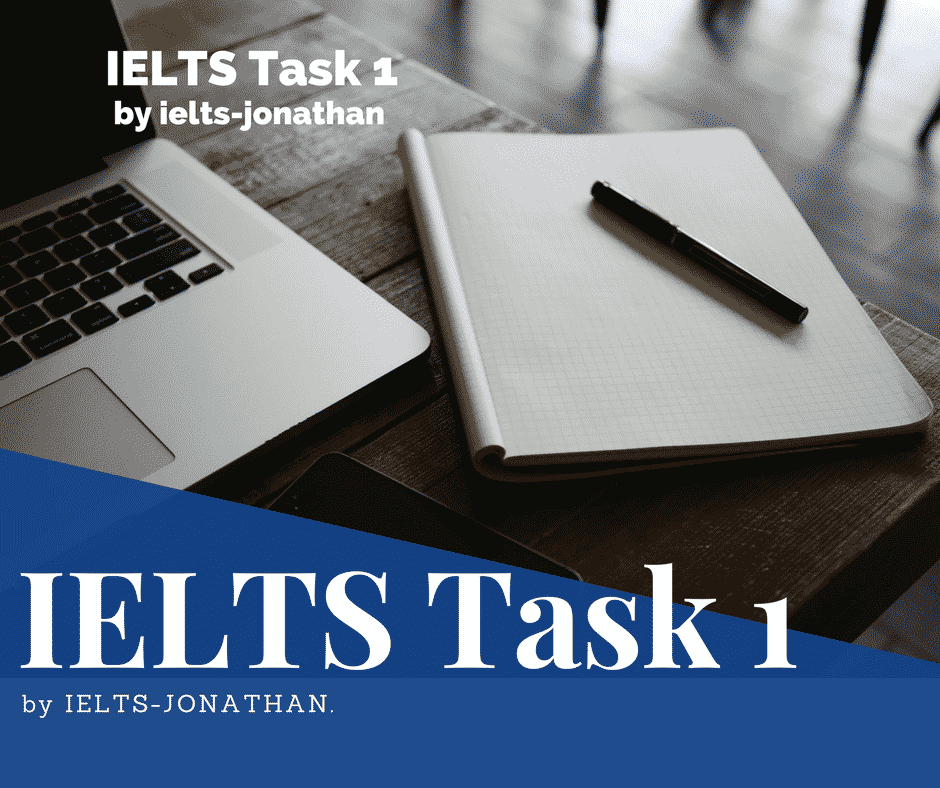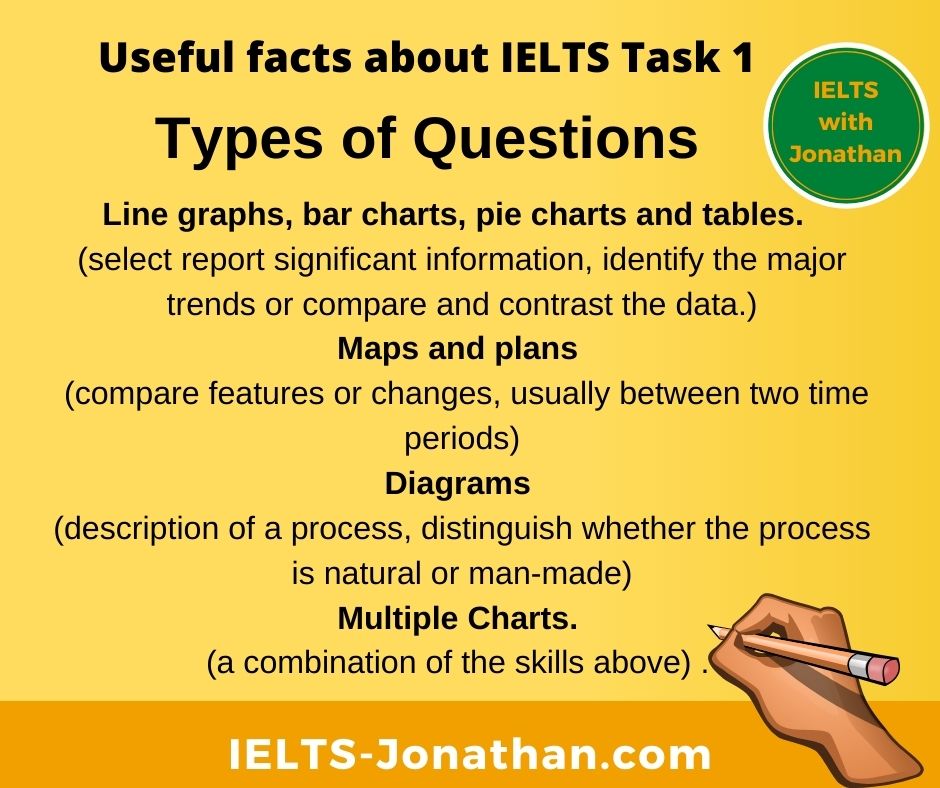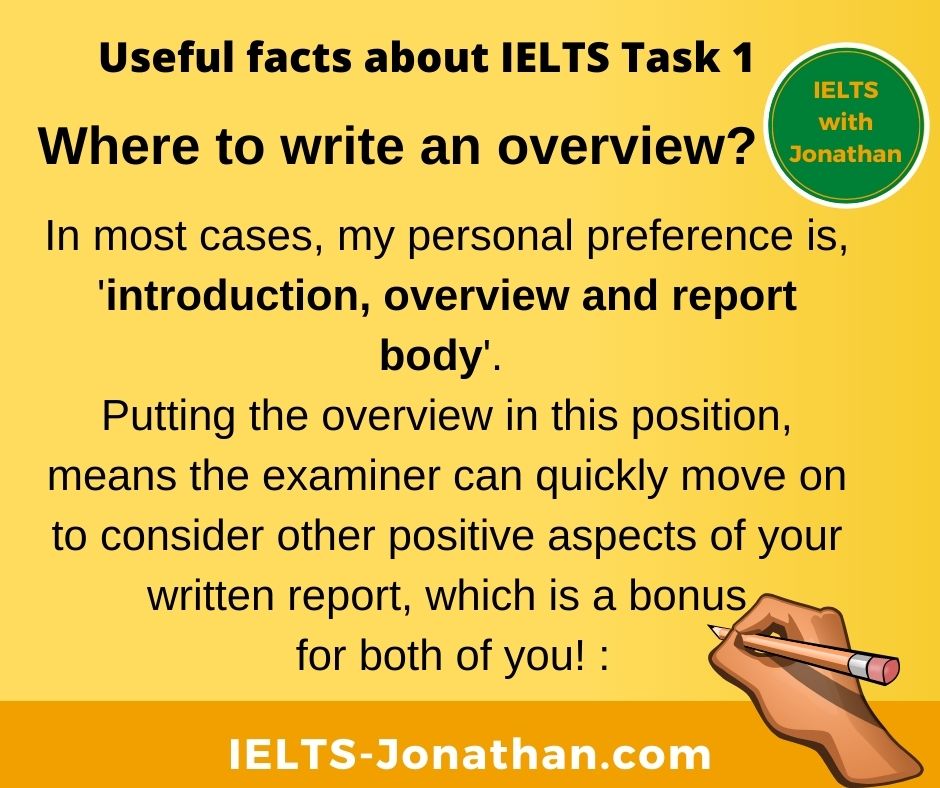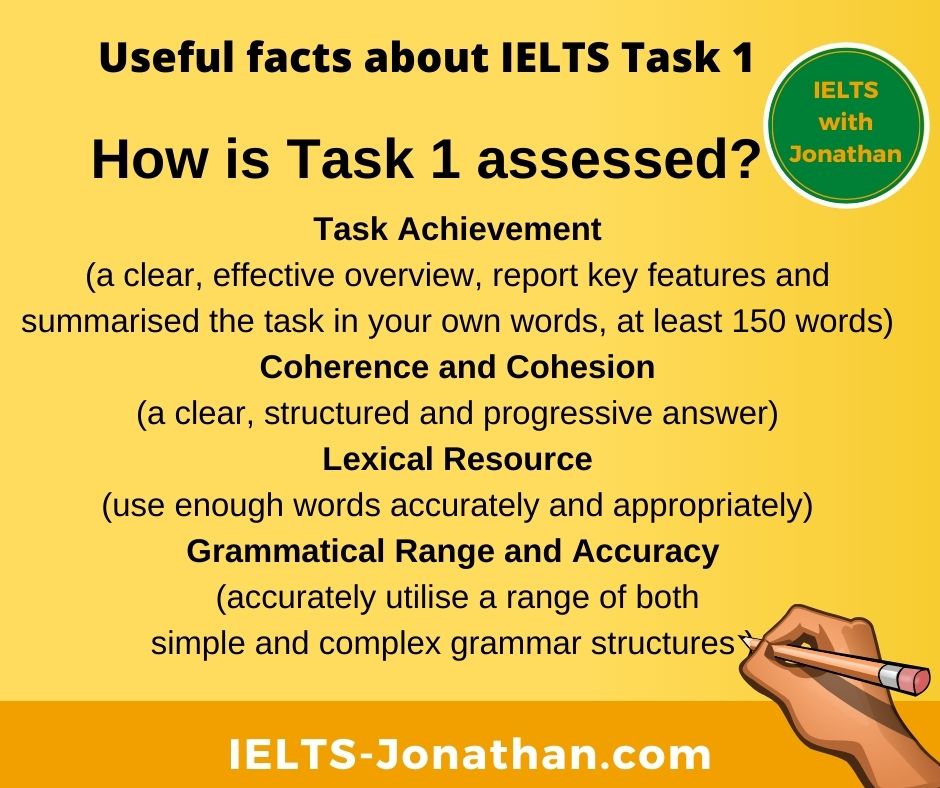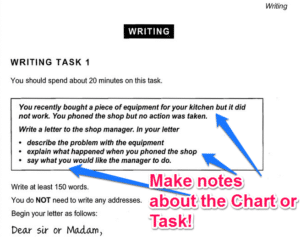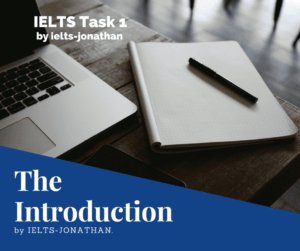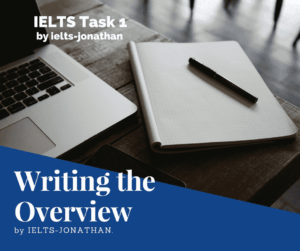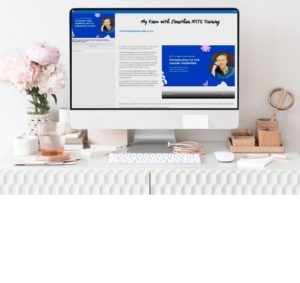What is Task 1 IELTS writing
IELTS academic writing is designed to accurately test your skills at writing clear, coherent and organised English for academic study.
An IELTS Task 1 writing question is a written response to visual information where you need to describe the task in your own words.
What is the difference between IELTS Task 1 and IELTS Task 2?
Students often get confused about the differences and similarities between Task 1 and Task 2 and often think of them both as essays.
To make it clear Task 1 can be thought of as a ‘report’ and Task 2 an academic ‘essay’.
The ides of a report and and essay is the main difference between Task 1 and Task 2.
Task 1 is a report and is merely a description of something, whereas Task 2 relies heavily on your opinions and is written in the style of an essay.
What does Task 1 assess?
The primary task is to assess how a candidate would cope, in the medium of English, with material you would expect to find in academic study at university.
Assessment tasks test how a student can accurately describe and summarise as well as compare different types of information where needed.
Tasks may require a number of sub-skills, such as being able to describe changes over time, being able to compare trends or compare and contrast figures in tables or explaining how something works.
What are the types of IELTS questions?
I’ve identified seven types of question you need to practice before the actual test.
In line graphs, bar charts, pie charts and tables, you need to select important statistical information and report the most significant information, identify the major trends or compare and contrast the data.
Maps and plans require you to compare features or changes, usually between two time periods.
Diagrams require a description of a process. While there is usually no time period, you need to distinguish whether the process is natural, man-made or even a combination of the two. This will affect the language structures you can use.
The last question is often known as Multiple Charts. As the title suggests, a combination of the skills above might be needed, and there may be changes to the structure of your report.
Language to use
One major aspect of the Task 1 test is the need to distinguish between the formal language of academic writing and the general English that students may have learnt in class or with friends.
The more you practice and read around IELTS questions and topics, the more familiar you will be with the style of language you need to use.
However, you may still need a teacher to give feedback on your writing. What might be academic in your language may not always translate well into academic English.
The type of language that you need to quickly avoid in your writing is:
- Informal Language -There should be no language such as ‘kids‘ when we want to describe children.
- Personal Language – There should not be any 1st person language, such as ‘I‘ or ‘my‘.
- Emotive Language – There should be no language that suggest emotive feeling, such as ‘The total number is really big‘
- Using Contractions – The only punctuation should be commas, apostrophes and full stops, so no we’ve, aren’t or isn’t.
How can you structure your report?
Whichever writing question you are answering, the basic structure of a task 1 report remains the same.
There should be a clear introduction, an informative overview and a main body paragraph.
The introduction should be clearly written in your own words and summarises the purpose of the visual.
The overview is a summary sentence of the most noticeable features or trends. These are often clearly obvious.
The main body report is where the important or Key Information is described.
The only differences in structure might be in the position or placement of the overview.
Where does the overview come in the structure?
There is no clear guidance from IELTS about this question, and teachers give different advice about where the overview should be.
In my view, there are three options and my personal preference.
The overview can come as part of the introduction. This means the report will only contain two paragraphs, a combined overview and introduction and the report body.
The second position is at the end of the report, so the structure would be introduction, report body and overview.
The third position is between the introduction and the report body, like this: introduction, overview and report body.
In most cases, my personal preference is, ‘introduction, overview and report body’.
Putting the overview in this position means the examiner can quickly move on to consider other positive aspects of your written report, which is a bonus for both of you! 🙂
How is IELTS Task 1 assessed?
Task 1 is assessed using four marking criteria. The examiner uses these to give your overall mark.
The first criteria is Task Achievement.
Task Achievement
This refers to a number of points but mainly considers whether you have included a clear, effective overview, have successfully reported the Key Features and summarised the task in your own words.
To do this successfully, it is fair to say you need to write at least 150 words within 20 minutes.
Coherence and Cohesion
In this area the examiner looks at your ability to write a clear, structured and progressive answer.
For example, the examiner will consider whether paragraphs been used effectively and whether sentences and ideas are linked with suitable linking words and phrases to make the answer organised and logical. Showing this kind of progression is important.
Lexical Resource
To assess you awareness in vocabulary the examiner considers your ability to use words accurately and appropriately.
So they will look at how you have spelt words, consider if word endings are accurate or correct, whether the word choices are formal and appropriate and whether you know and are able to display enough vocabulary to avoid repetition in your writing.
Grammatical Range and Accuracy
The last area of assessment is related to grammar.
Not only does this assess how much your grammar is error free, but it also assesses whether you can utilise a range of both simple and complex grammar structures and display them accurately, and not inappropriately, according to the task question.
As an IELTS teacher, it’s easy to see candidates make silly mistakes which lose marks and lowers the Band Score.
Good news for Task 1 writing.
There are many simple errors that are easy to correct.
There are basic rules to follow and remember.
Number of words: 150.
-
This means that you should NOT write less than 150 words. It is always better to write more than the number of words given as you are not penalised for being over the word count. This is easy to practise at home.
Don’t count the number of words in the test.
If you count the number of words when you are doing an actual test, you are wasting valuable time. 🙁
Always count the number of words you write when you do practice tests at home or in class. This will help you get an idea of what a 150 word report looks like in your own handwriting.
Paraphrase the introduction
-
Another tip is NOT to use words and sentences from the text. If you do use words from the question without changing them in any way, these words are not counted, so can lose marks for being under length.
Use synonyms
Try to use synonyms.
There are some words you will not be able to change, e.g. ‘chart’ or ‘map’, but try to use synonyms as much as possible:
Let me give you a very simple example:
e.g. (The question paper states) ‘The chart shows…’ (Your written answer) ‘The chart illustrates….’ or ‘On the chart we can see….’
In some questions, there is often plenty of vocabulary you can draw on.
In other questions, you may need to use your own language.
Remember using synonyms is especially important in the introduction but less so in the main body where you probably have to use the language from the question.
-
Do NOT write anything about the ‘x-axis’ and ‘y-axis’ – these are just details that the reader (examiner!) understands anyway. The examiner wants to see your ability to describe the significant features only.
Time allowed: 20 minutes including checking time.
-
Be strict with your time.
As Task 2 is worth more than Task 1, stop writing Task 1 after 20 minutes, and start Task 2.
Return to Task 1 if you have time near the end of the writing test.
-
It is important to decide quickly on key features.
Finding at least 3 key features should give you enough material to write a minimum of 150 words. At this stage you will be looking to use common grammatical collocations.
So you may notice the highest or the lowest points or numbers, the features that have changed the most or the least, the things which are the same, have remained the same, or which are different.
Key features should be obvious and geneuine ILETS test questions should provide them. It should only take a few minutes to spot the key features but it’s still a good idea to note these on the question paper so you remember them
It is also important to notice an ‘overall trend’, i.e something which is very general and describes the chart or table as a whole.
I’ve put together a post on ‘overall trends in Task 1 Writing here‘
Make notes on the Test Paper.With any IELTS task, always make sure you write down the key notes so you remain on task.
Include specific data related only to KEY Features and DON’T make a list of numbers.
The IELTS band descriptors describe how the candidate should summarize the key features and compare.
- Only summarise the key features and ignore the minor ones.
So, you can mention details such as ‘imports decreased by 30%, sales went up from £40 to £80, numbers peaked at 500/ in 2010, or inflation rose by 5%, but don’t report everything or you will have a list of numbers.
-
You should analyse and make comparisons but only ‘where relevant‘
Sentences such as these,
‘In 2000 only 20% of UK citizens owned an Android mobile phone, whereas 10 years later this number had trebled to 60%. In 2001 30 per cent of British households had an internet connection but by 2016 this percentage had risen to 80%.’
are good, but don’t compare every number, figure or change.
-
It is important to use linking words for cohesion and coherence but this is unnecessary for every sentence. In fact, too many linking words can sound unnatural! You are looking to arrange you work logically, with just enough signalling words to help the reader.
The Key Features are important and NOT your opinion.
-
You might be lucky and have some general knowledge or expertise regarding the question you’re given.
This may help you read and understand the data. You might disagree with the data too. You may understand why a change or feature presented in the chart has happened but DON’T express that opinion.
You will lose marks as you will probably be using your own opinion and not referring to the question data.
Never say that the data is wrong, just report what you see.
Lastly, it is important to have an ‘overview’ in your writing.
Many candidates find this, the OVERVIEW, the most difficult section of Task 1, but without the overview your writing isn’t complete AND you wont ever go above BAND 5.
A very good way to start an ‘overview’ is to always include a sentence beginning with ‘Overall,…’
Overall, the number of people in full-time education increased.
This can come either at the start of your writing (in the introduction), as a paragraph after the introduction or at the end as your final paragraph.
I prefer this structure, Introduction, Overview, and then the Main Report, but it is up to you!
Overall can be used to describe a trend that is noticeable over the complete chart, graph or diagram.
Another way to add information about a trend is to use ‘generally….
‘Overall the number of people in full-time education increased, however, generally the greatest increase in students numbers were seen in females/ were seen in 1990/ were seen in Further education.
Generally, can be used to describe a trend that is not always true or is different to the most noticeable trend.
However, try not to repeat information that you have already written about.
Next steps..
So now you know the basics of IELTS Task 1, you can use the posts I’ve written below to approach the different types of question in detail and the subskills you need.
Adjectives and Adverbs for IELTS Task 1
Comparing and Contrasting Language for IELTS Task 1
Working Correctly with Numbers for IELTS TASK 1
How to write Overview, Body and Introduction paragraphs.
How to write an Introduction.
How to write the main report for IELTS Task 1.
Official Practice Materials
If you feel you’re ready for the Task 1 Writing you can practice Task 1 and Task 2 questions here.
Just note that the IELTS Academic test has a different Writing test to the IELTS General test.
Downloadable IELTS Academic Writing Samples
Downloadable Writing Answer Sheet
IELTS Writing answer sheet task 1
Downloadable Writing Sample Script
I’m Jonathan
I’ve taught IELTS and University English in more than a dozen universities and schools around the world.
I’m a parent, traveller and passionate about language teaching and helping students achieve their dreams.
Whilst living in Austria or working in Asia, I run IELTS courses to help students get to where they want to be.
If you are serious about IELTS, connect with me to see how I can help you.

